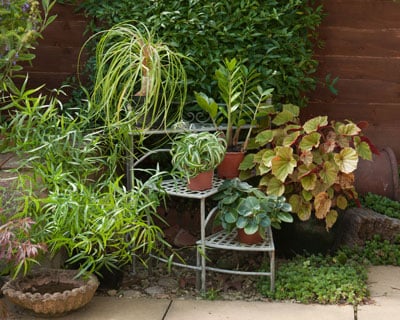Moving houseplants outdoors for summer
Many houseplants will really benefit from a summer holiday in a sheltered spot in the garden. Here’s everything you need to know about taking your houseplants outside
Many of our most common leafy houseplants hail from rainforest habitats. They can be well outside their comfort zone in our dry, low-humidity homes; battling with central heating which dries out their leaves, and coping with limited levels of natural light.
So when night-time temperatures rise in summer, the opportunity should be taken to treat your houseplants to something a little more akin to their natural habitat – and they will thank you for it.
Help your plants get the most out of their summer break with these top tips from Rob Stirling, a houseplant and orchid specialist from the RHS Advisory team.
Why should I take my houseplants outside?
There are many benefits to moving houseplants outdoors in summer. Rain falling on their leaves – an almost daily occurence in many of their natural habitats, but one they can’t benefit from in the home environment – helps to keep the leaves clean and dust-free. Most houseplants thrive in the higher
Fresh air movement over stems and foliage also delivers carbon dioxide to the leaves, which the plants use along with water and the better intensity of light found outdoors to photosynthesise and create the sugars they need for growth and repair.
When should I move my houseplants outdoors?
Sub-tropical houseplants, such as Cymbidium, Clivia and Alocasia, can be put outside when the night time temperatures are consistently above 10-12C (50- 54F). Spathiphyllum (peace lily), Philodendron, Sansevieria (snake plant) and rex begonias require night-time temperatures above 13C (55F), while Calathea and Maranta (prayer plants) require temperatures of 15C (59F) or more.
It’s worth researching the temperature requirements for your particular species, and keeping an eye on the forecast to find the best window of opportunity for moving your houseplants outdoors.
Where should I put them, and how should I treat houseplants while outside?
The best place to put houseplants outdoors will depend on their individual requirements, as the plants we collectively term ‘houseplants’ are a diverse group that come from widely different habitats, from shady rainforests to dry, arid regions.
Generally, all plants when put outside should be grown in bright shade, gradually exposing them to more and more direct sunlight for those that require it. Even cacti can burn if exposed to direct sunlight outdoors when first moved from indoors. This is because the light levels are far more intense outdoors than indoors.
Most leafy houseplants, such as Calathea, Alocasia and Anthurium, will need a shady, sheltered spot that enjoys plenty of natural light but is out of direct sunlight – akin to a rainforest floor. Cacti and succulents are best protected against excessive rainfall, which can lead to rot, so keep the plants in a porch or covered area.
Keep an eye on soil moisture in the pots while your houseplants are outdoors, as the increased air movement can have a drying effect compared to the still environment indoors.
Houseplants are best moved back indoors when night time temperatures are forecast to drop below 10C (50F).
If possible, move the plants into a cool room initially, until they have re-acclimatised to indoor conditions – usually after 2 or 3 weeks. Centrally heated rooms can have much lower atmospheric humidity than that which the plants have enjoyed outside, and the sudden change can cause water-stress, resulting in leaf drop or browning foliage.
Atmospheric humidity can be increased locally around the plants by standing them in a large tray of moist gravel or hydroleca, which allows the moisture to evaporate into the air around the plants. This is far more effective than spraying. Using an ultrasonic humidifier among the plants can also help.
Are there any houseplants that I should leave indoors?
Tropical plants that require a higher minimum temperatures than those usually found outdoors in the UK are best left indoors. It’s always best to research the plant’s requirements before moving them outdoors. For example, Phalaenopsis (moth orchids) will not tolerate a minimum temperature lower than 18C (65F).The notoriously fussy Ficus benjamina (weeping fig) also hates being moved to a new position, even indoors, and would protest by shedding many leaves, so is best left undisturbed.
Find out more tips on how to grow houseplants in our houseplant growing guide.


